
Unlocking the Secrets of Glass Manufacturing Processing: From Raw Material to Architectural Masterpiece
Glass Manufacturing Processing is a vital aspect of the glass industry, encompassing a diverse range of techniques and methods aimed at transforming raw glass into functional and aesthetically pleasing products. From architectural glazing to automotive applications, glass processing plays a crucial role in shaping the modern built environment. In this article, we will explore the various facts about glass processing, as well as the different types of processes involved.
Facts about Glass Manufacturing Processing:
Ancient Origins: The history of glass processing dates back thousands of years, with evidence of glassmaking techniques found in ancient civilizations such as Mesopotamia, Egypt, and Rome. Early glassmakers utilized primitive methods to produce glass objects, including blowing, casting, and molding.
Modern Innovations: Over the centuries, advancements in technology and manufacturing processes have revolutionized the glass industry, leading to the development of new techniques for processing glass on a large scale. From automated production lines to precision cutting and shaping equipment, modern glass processing facilities employ state-of-the-art machinery to achieve high levels of efficiency and precision.
Versatility: Glass is an incredibly versatile material that can be processed and manipulated in numerous ways to create a wide range of products. From flat glass used in windows and mirrors to curved glass used in automotive windshields and architectural facades, the possibilities for glass processing are virtually endless.
Customization: Glass Manufacturing Processing allows for a high degree of customization, enabling designers and architects to create unique and innovative glass products tailored to specific project requirements. Techniques such as etching, sandblasting, and digital printing allow for intricate patterns, textures, and designs to be applied to glass surfaces, adding visual interest and personality to architectural and interior spaces.
Sustainability: With growing concerns about environmental sustainability, the glass industry has made significant strides in developing eco-friendly glass processing techniques. Recycled glass, also known as cullet, is commonly used as a raw material in glass manufacturing, reducing the need for virgin materials and minimizing waste.

Additionally, energy-efficient production methods and recycling initiatives help reduce the carbon footprint of glass processing operations.
Types of Glass Processing:
Cutting and Shaping: One of the fundamental processes in glass processing is cutting and shaping, which involves using precision cutting tools to size and shape raw glass sheets according to project specifications. Techniques such as water jet cutting, diamond sawing, and laser cutting are commonly used to achieve accurate and clean cuts in glass.
Tempering: Tempering is a heat treatment process used to increase the strength and durability of glass. During tempering, raw glass is heated to high temperatures and then rapidly cooled, creating internal stresses that make the glass stronger and more resistant to impact and thermal shock. Tempered glass is widely used in applications requiring safety and durability, such as windows, doors, and shower enclosures.
Laminating: Laminating is a process that involves bonding multiple layers of glass together with an interlayer material, typically a polymer such as polyvinyl butyral (PVB) or ethylene-vinyl acetate (EVA). The resulting laminated glass offers increased strength, safety, and sound insulation properties compared to monolithic glass.
Laminated glass is commonly used in applications requiring security, such as bulletproof glass and hurricane-resistant windows.
Coating: Glass coating is a surface treatment process used to enhance the performance and appearance of glass products. Various types of coatings, such as low-emissivity (low-E) coatings, solar control coatings, and self-cleaning coatings, can be applied to glass surfaces to improve energy efficiency, reduce glare, and repel dirt and water. Coated glass is widely used in architectural glazing, automotive windshields, and electronic displays.
Decorative Techniques: Glass Manufacturing Processing also encompasses a variety of decorative techniques used to enhance the aesthetic appeal of glass products. These techniques include etching, sandblasting, acid-etching, and digital printing, which can be used to create custom patterns, textures, and designs on glass surfaces. Decorative glass is commonly used in interior design applications such as partitions, doors, and wall panels.
Annealing: Annealing is a process used to relieve internal stresses in glass that may occur during manufacturing or processing. During annealing, glass is gradually cooled at a controlled rate to minimize the risk of cracking or breakage. Annealed glass is less prone to thermal stress and is commonly used in applications where strength and durability are not critical, such as picture frames and decorative glassware.:
Glass processing is a dynamic and multifaceted field that encompasses a wide range of techniques and methods for transforming raw glass into finished products. From cutting and shaping to tempering, laminating, and coating, glass processing techniques play a crucial role in shaping the modern built environment and enhancing the functionality and aesthetic appeal of architectural and design projects. As technology continues to advance and sustainability becomes increasingly important, the glass industry will continue to innovate and evolve, pushing the boundaries of what is possible with this versatile and timeless material.





